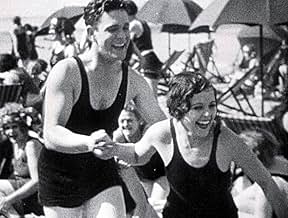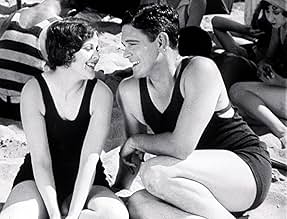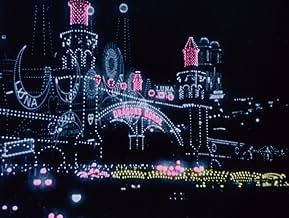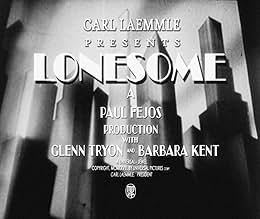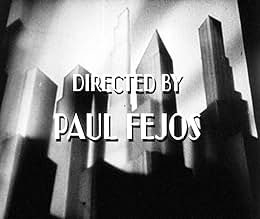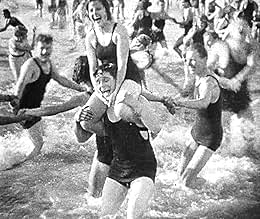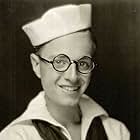IMDb RATING
7.7/10
2.8K
YOUR RATING
Two lonely people in the big city meet and enjoy the thrills of an amusement park, only to lose each other in the crowd after spending a great day together. Will they ever see each other aga... Read allTwo lonely people in the big city meet and enjoy the thrills of an amusement park, only to lose each other in the crowd after spending a great day together. Will they ever see each other again?Two lonely people in the big city meet and enjoy the thrills of an amusement park, only to lose each other in the crowd after spending a great day together. Will they ever see each other again?
- Awards
- 1 win total
Gusztáv Pártos
- Romantic Gentleman
- (as Gustav Partos)
Henry Armetta
- Ferris wheel guy
- (uncredited)
Edgar Dearing
- Cop
- (uncredited)
Louise Emmons
- Telephone Caller
- (uncredited)
Fred Esmelton
- Swami
- (uncredited)
Jack Raymond
- Barker
- (uncredited)
Churchill Ross
- Telephone Caller
- (uncredited)
Featured reviews
There are at least three levels at which 'Lonesome' is an extremely interesting film.
1. It is a sweet story of two lonely people in a big anonymous city who meet, fall in love and lose each other. The picture is well-acted, and the two lead actors Barbara Kent (Mary) and Glenn Tryon (Jim) are perfectly matched; they both give nuanced and sensitive performances.
2. The style of the picture is almost documentary, which makes it interesting from a social history point of view. In some ways, nothing much has changed over the last 100 years: People are still commuting to work, the subway in New York was as crowded as the London Underground is today (I don't know about New York in 2022), you get annoyed at the same kind of behaviour of your fellow passengers (e.g. Eating smelly food) etc. Obviously other things have changed: The type of work we do, for example, and we no longer bond over serialised novels published in newspapers that we read. Nevertheless, we are still living in what is recognisably the same kind of society. I found this aspect of 'Lonesome' particularly interesting.
3. Technologically, 'Lonesome' was highly innovative, being the perfect example of a film that came out during the transition phase from silent pictures to talkies to colour films. Initially, it looks like a normal black and white silent film to which music and some sound effects have been added. However, some scenes have spoken dialogue, and some are even in colour, or at least partly colorised. People back then must have felt they were living in an exciting age of innovation; I am sure they expected that within the next few years, all talking and maybe even all colour films would become the norm.
So why am I giving 'Lonesome' no more than 8 stars? Well, there are a few flaws. First, the dialogue sounds as stilted as if the actors were reading it from a sheet, and on top of that, a bit of it does not seem to make much sense (the scene at the police). It feels like an afterthought, like something director Pal Fejös inserted after having finished the rest of the film. Second, the colour effects are not particularly nice to look at. The colours are just garish. They were certainly innovative, but the film would look better without them. And finally, the plot is so simple that it barely exists. The only real problem the characters face appears almost at the end of the film, and its resolution does not logically follow from anything that happened earlier; it just comes about by chance. I am reserving 9 stars for pictures that are as good as perfect, and 10 for those that have some particular emotional quality or style that takes them into the small group of my favourite films (like e.g. 'North by Northwest', which for my taste must be one of the most stylish films ever made). 'Lonesome' is very good, but not as good as that. Hence 8 stars.
1. It is a sweet story of two lonely people in a big anonymous city who meet, fall in love and lose each other. The picture is well-acted, and the two lead actors Barbara Kent (Mary) and Glenn Tryon (Jim) are perfectly matched; they both give nuanced and sensitive performances.
2. The style of the picture is almost documentary, which makes it interesting from a social history point of view. In some ways, nothing much has changed over the last 100 years: People are still commuting to work, the subway in New York was as crowded as the London Underground is today (I don't know about New York in 2022), you get annoyed at the same kind of behaviour of your fellow passengers (e.g. Eating smelly food) etc. Obviously other things have changed: The type of work we do, for example, and we no longer bond over serialised novels published in newspapers that we read. Nevertheless, we are still living in what is recognisably the same kind of society. I found this aspect of 'Lonesome' particularly interesting.
3. Technologically, 'Lonesome' was highly innovative, being the perfect example of a film that came out during the transition phase from silent pictures to talkies to colour films. Initially, it looks like a normal black and white silent film to which music and some sound effects have been added. However, some scenes have spoken dialogue, and some are even in colour, or at least partly colorised. People back then must have felt they were living in an exciting age of innovation; I am sure they expected that within the next few years, all talking and maybe even all colour films would become the norm.
So why am I giving 'Lonesome' no more than 8 stars? Well, there are a few flaws. First, the dialogue sounds as stilted as if the actors were reading it from a sheet, and on top of that, a bit of it does not seem to make much sense (the scene at the police). It feels like an afterthought, like something director Pal Fejös inserted after having finished the rest of the film. Second, the colour effects are not particularly nice to look at. The colours are just garish. They were certainly innovative, but the film would look better without them. And finally, the plot is so simple that it barely exists. The only real problem the characters face appears almost at the end of the film, and its resolution does not logically follow from anything that happened earlier; it just comes about by chance. I am reserving 9 stars for pictures that are as good as perfect, and 10 for those that have some particular emotional quality or style that takes them into the small group of my favourite films (like e.g. 'North by Northwest', which for my taste must be one of the most stylish films ever made). 'Lonesome' is very good, but not as good as that. Hence 8 stars.
A sister of Sunrise and The Crowd, this film is more emotional and poetic than those landmarks and every bit as great. The plot concerns two working class American types, he works in the factory, she works on the intercom who meet by chance on a fairground and fall in love and then lose each other without knowing where the other lives.
The film's beginning is to be treasured, it follows in detail the morning ritual of first the girl and then the man in their respective homes. The effect conveyed is the organization and elegance of women over the tardy, rushed, half-baked activities of men. The love story between the two characters is so beautifully etched and played so naturalistically by the actors(Barbara Kent and Glenn Tryon) that the sense of loss in the latter half of the film is all the more painful and heart-breaking. The film deals with a certain truth about living in a city that has remained constant even after a good 80 years. At once a constant sense of community and at other an equally constant sense of loneliness from being in a crowd.
The film's beginning is to be treasured, it follows in detail the morning ritual of first the girl and then the man in their respective homes. The effect conveyed is the organization and elegance of women over the tardy, rushed, half-baked activities of men. The love story between the two characters is so beautifully etched and played so naturalistically by the actors(Barbara Kent and Glenn Tryon) that the sense of loss in the latter half of the film is all the more painful and heart-breaking. The film deals with a certain truth about living in a city that has remained constant even after a good 80 years. At once a constant sense of community and at other an equally constant sense of loneliness from being in a crowd.
... and I could say the same thing about Fejos' "Broadway", made a year later. Fejos recounts the tale of two lonely New Yorkers, Jim (Glen Tryon) and Mary (Barbara Kent), who find love and each other during a half day holiday at the beach and Coney Island. You first see the workday from Jim and Mary's perspective as they are ruled first by the tyranny of the alarm clock and then the tedium of the workday as you see a clock overlaying the image of each at work. Jim is a low-level machine operator, and Mary is a telephone operator. Then there are "the crowds". Jim and Mary are crowded at breakfast, at a diner filled with patrons, crowded on the subway, crowded at work, and crowded at the beach and amusement park. Yet both of them are completely alone in the world, which, especially in the attractive Miss Kent's case, seems somewhat inconceivable.
This late era silent has a dearth of title cards, which does not subtract from the film's enjoyment. In fact, what does subtract just a little are the short dialogue scenes that just don't make sense. One scene is Jim and Mary on the beach suddenly in the dark AND in color, with the crowd removed. Nothing they say shines any light on their situation or feelings at all. Another one is in a courtroom where Jim has been detained for being unruly. He gives a speech like a Bolshevik basically shaming the judge and ... the judge lets him go???? This social awareness seems very strange stuff coming from Jim who, up to that point, has seemed to be a very uncomplicated fellow. Very strange, but typical of talking scenes inserted into silent films at the dawn of sound.
What is extra special about this film is to see the lives of working class people in 1928. Notice that the workday that Jim and Mary are going through is a Saturday, and this was the norm back then and until some time after WWII. People would normally work half a day on Saturday and have only Sunday in its entirety as a day off. Catch this film if you can, even if you are not a huge silent film buff.
This late era silent has a dearth of title cards, which does not subtract from the film's enjoyment. In fact, what does subtract just a little are the short dialogue scenes that just don't make sense. One scene is Jim and Mary on the beach suddenly in the dark AND in color, with the crowd removed. Nothing they say shines any light on their situation or feelings at all. Another one is in a courtroom where Jim has been detained for being unruly. He gives a speech like a Bolshevik basically shaming the judge and ... the judge lets him go???? This social awareness seems very strange stuff coming from Jim who, up to that point, has seemed to be a very uncomplicated fellow. Very strange, but typical of talking scenes inserted into silent films at the dawn of sound.
What is extra special about this film is to see the lives of working class people in 1928. Notice that the workday that Jim and Mary are going through is a Saturday, and this was the norm back then and until some time after WWII. People would normally work half a day on Saturday and have only Sunday in its entirety as a day off. Catch this film if you can, even if you are not a huge silent film buff.
If only this remarkable movie hadn't had the misfortune to be released just when the enthusiasm for sound was sweeping all before it, it would probably have been more appreciated at the time and remembered today as one of the all-time classics. As an expression of the isolation of city life, it builds up an atmosphere of desperation, in spite of its romance with a happy ending. The scene where the boy searches frantically for the girl throughout crowded Coney Island, buffeted this way and that by the uncaring throngs, turned away by the indifferent faces of the amusement park workers, has few equals for anguish. Also unforgettable is the montage that cuts from one to the other of the lovers (who have not yet met) while they are at work, the one at a factory, the other at a telephone switchboard; the motions of the hands and the machines build to a frantic, overwhelming pace.
Unfortunately, before the movie was released it was sadly mangled by the insertion of several sound sequences, which stop the continuity dead with their absolute stasis, and feature dialogue so thunderously inane you have to suspect it was written by the sound technician. Nonetheless, "Lonesome" remains one of the most sophisticated examples of the silent movie, an art form that was killed by sound almost as soon as it had reached maturity.
Unfortunately, before the movie was released it was sadly mangled by the insertion of several sound sequences, which stop the continuity dead with their absolute stasis, and feature dialogue so thunderously inane you have to suspect it was written by the sound technician. Nonetheless, "Lonesome" remains one of the most sophisticated examples of the silent movie, an art form that was killed by sound almost as soon as it had reached maturity.
...that I cannot stand my own company...says the hero.
This could be the optimistic side of King Vidor's "the crowd".This era was a time when the pursuit of happiness was legitimate and "even with a face like that" you could hope to find the woman of your dreams.Robert Siodmak would make "Menschen Am Sonntag" and Marcel Carné "Nogent Eldorado Du Dimanche" soon after ,and would replace Coney Island by the banks of the Rhine or of the Seine.
1928 was the year before the crash .Even in the biggest city in the world ,you can be lonelier than the loneliest of creatures.He pretends he is a millionaire ,she pretends she is a princess ;in fact he is a working man,she is an operator .
It is not as optimistic as it seems at first sight.The crowds are hostile and do nothing to help them ,they are as selfish as today's crowds .
"Lonesome " is an important movie,if only for its simplicity and its spontaneity.Everything happens in the short space of one day (from the rude awakening to the night when solitude becomes even harder to bear ) and the two principals are really endearing ,almost matching Janet Gaynor and Charles Farrell.
NB:Paul Fejos would continue his career in France in the early thirties where he directed Annabella in a tragic melodrama ("Marie Legende Hongroise")and a remake of Feuillade's "Fantomas", the first third of which surpasses the original .
This could be the optimistic side of King Vidor's "the crowd".This era was a time when the pursuit of happiness was legitimate and "even with a face like that" you could hope to find the woman of your dreams.Robert Siodmak would make "Menschen Am Sonntag" and Marcel Carné "Nogent Eldorado Du Dimanche" soon after ,and would replace Coney Island by the banks of the Rhine or of the Seine.
1928 was the year before the crash .Even in the biggest city in the world ,you can be lonelier than the loneliest of creatures.He pretends he is a millionaire ,she pretends she is a princess ;in fact he is a working man,she is an operator .
It is not as optimistic as it seems at first sight.The crowds are hostile and do nothing to help them ,they are as selfish as today's crowds .
"Lonesome " is an important movie,if only for its simplicity and its spontaneity.Everything happens in the short space of one day (from the rude awakening to the night when solitude becomes even harder to bear ) and the two principals are really endearing ,almost matching Janet Gaynor and Charles Farrell.
NB:Paul Fejos would continue his career in France in the early thirties where he directed Annabella in a tragic melodrama ("Marie Legende Hongroise")and a remake of Feuillade's "Fantomas", the first third of which surpasses the original .
Storyline
Did you know
- TriviaIt was one of the first motion pictures to have sound and a couple of talking scenes. It was released in both silent and monaural versions. Some scenes in existing original prints of the film are colored with stencils.
- Alternate versionsProduced in both sound and silent versions. The sound version was 6,785 feet in length, and the silent version was 6,193 feet.
- ConnectionsFeatured in Fejezetek a film történetéböl: Az amerikai film kezdetei (1989)
- SoundtracksAlways
(uncredited)
Written by Irving Berlin
[Played by dance orchestra at ballroom]
Sung by Nick Lucas
[on Brunswick recording played in last scene]
- How long is Lonesome?Powered by Alexa
Details
- Runtime1 hour 9 minutes
- Sound mix
- Aspect ratio
- 1.19:1
Contribute to this page
Suggest an edit or add missing content




